ADA Act: Equal Opportunities to the Employees
Individuals with disabilities should not be discriminated against with regards to application, job training, career advancement, and discharge (Jones, 2003).
- Neither the entities of public level, nor those of state level have the right to discriminate against the individuals with disabilities.
- Public accommodations should be equally accessible for all the individuals.
- Telecommunications services should be equivalent for all the consumers, including those with hearing disabilities.
*The provisions of the act spread to the organizations with 15 or more employees (Mathis & Jackson, 2007).
The Americans with Disabilities Act (ADA) was passed in 1990 . It is regarded as a civil rights law aimed at protection of the rights of disabled people at work and in everyday activities (Miller & Holness, 1998). This act defines disability as “a physical and mental impairment that substantially limits one or more of a person’s major life activities” (Youngberg, 1998, p. 454). Since 1990, the Act has been modified and amended several times to ensure broader protections for the employees with disabilities.
Considering the case study of Mary Ann, it may be stated that the ADA Acts proves to be quite effective. Mary Ann, a social worker, was denied in promotion because of her cancer history (a number of employees associate such history with absenteeism and other work-related problems: “For many cancer survivors, job discrimination is often worse than fighting the disease. It is estimated that 25 percent of survivors of cancer experience some form of job discrimination” (Yuen, Skibinsky, & Pardeck, 2003, p. 165). Mary Ann, one of such survivors, was denied in promotion to a supervisory position once the administrator learned about her cancer history. Mary Ann filed a discrimination complaint with the U.S. Equal Employment Opportunity Commission and, under the ADA Act, the commission concluded that discrimination did take place (Yuen et al., 2003).
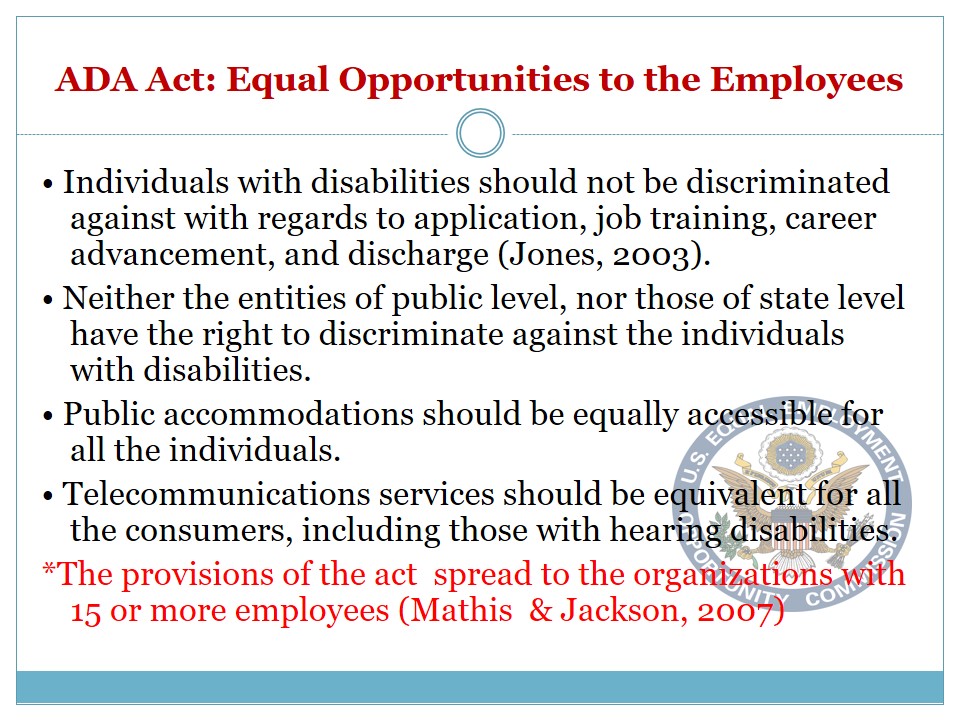
Discrimination in the Workplace: The Effects on Employees’ Motivation and Performance
- The level of stress which the employees are exposed to increases;
- Employees often start searching for new positions;
- Employees have less satisfaction with their jobs;
- Employees have decreased job commitment;
- Negative attitude towards job is developed;
- Individuals with disabilities develop psychological problems (Regmi, Naidoo, & Regmi, 2009).
Discrimination in the workplace has a direct effect on the employees’ performance and, in the first place, motivation. The individuals that have poor motivation are unable to perform well. In the organizations where the employees with disabilities are not discriminated against, “employee self-esteem and motivation increase, and optimum performance levels benefit the employees and the company” (Spechler, 1996, p. 238). In the opposite case, lack of motivation and low self-esteem result in poor performance and dissatisfaction of the employee with the job.
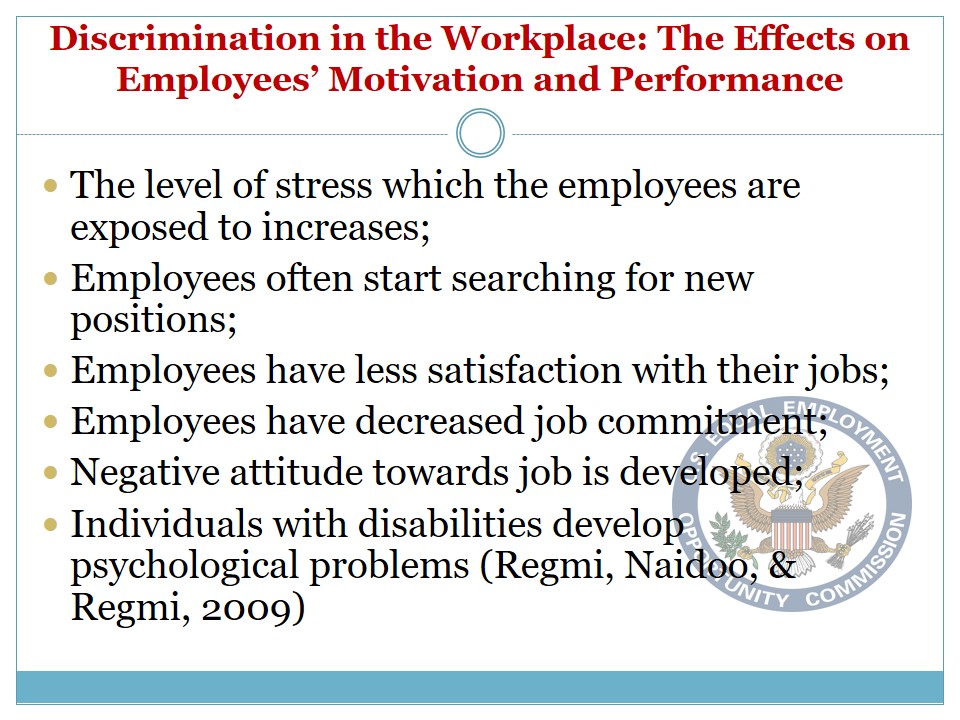
Maslow’s Hierarchy of Needs
Maslow regarded physical (or physiological) needs of a person as the basic ones; however, he considered that a person cannot be motivated until these needs are satisfied. These are followed by safety needs and acceptance needs (including love, belonging, friendship, etc). Quite important for human motivation are esteem needs that consist in the desire of an individual to be valued by others; finally, the need for self-actualization is the most important in this hierarchy for it concerns the desire of an individual “to maximize one’s potential and to accomplish something” (Koontz & Weihrich, 2006, p. 291). With regards to workplace discrimination, esteem and self-actualization are the most important in these hierarchy. In terms of the former, discrimination may result in low self-esteem of the employee and even the development of the inferiority complex, which will significantly decrease motivation and, consequently, job performance. In terms of the latter, the discrimination will lead to barriers in problem solving and creativity, which will have a negative effect on the employee’s performance.
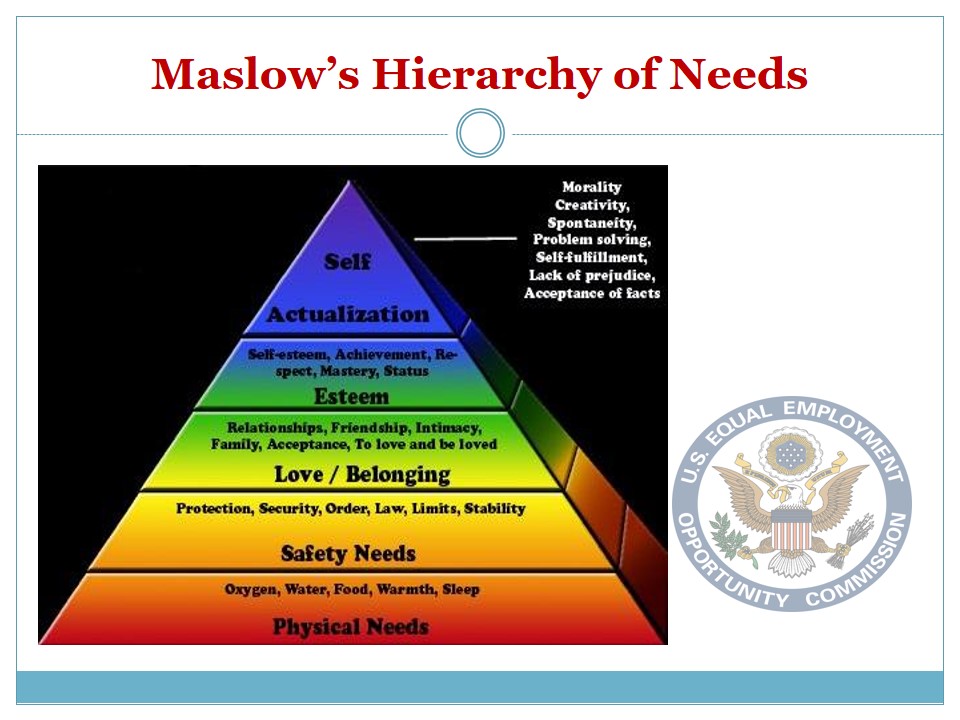
Alderfer’s ERG Theory Based on Maslow’s Hierarchy of Needs
Unlike Maslow’s theory, Alderfer’s theory presupposes the possibility of the employees’ working on multiple levels simultaneously, as well as advances an idea that employees discouraged by the complexity of the higher levels, may fall back to lower levels (the concept which Alderfer identified as frustration-regression) (Bogardus, 2009).
Basing on Maslow’s hierarchy of needs, Alderfer created his Erg (existence, relatedness and growth) theory. With regards to this theory, there are three major groups of need through which the individuals can move simultaneously and movement through them in different order for different people is possible (Pomoroff, 2005). If applied to the discrimination in the workplace, this theory presupposes that individuals with disabilities may be motivated by different things (for instance, an ordinary person might be motivated by growth needs, while for a disabled person satisfying relatedness needs is enough to be strongly motivated).
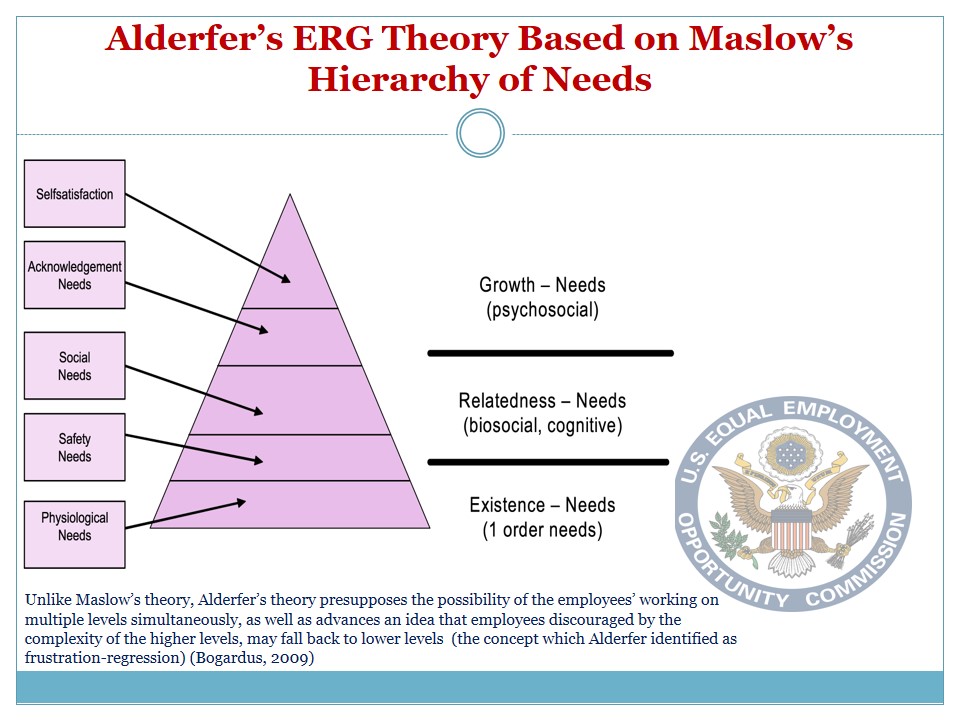
McClelland’s Theory of Needs: the Effect on Motivation
- Achievement motivation – an employee achieves his/her goals and requires feedback to confirm this achievement;
- Power motivation – this need is connected with the acquisition of personal prestige and desire of the employee to direct others;
- Affiliation motivation – the need in team membership and interaction with other employees (Boer, 2009).
According to McClelland’s Theory of Needs, these needs may be acquired by a person in the course of his/her life experiences (Saxena, 2009). The employees should ensure that employees with disabilities have a chance to satisfy these three needs; otherwise, these employees’ effectiveness and motivation will decrease, which will result in poor performance. Individual needs of employees with disabilities have to be taken into account because each of them may have different needs for achievement, affiliation and power, which inevitable tells on their job satisfaction. Thematic Appreciation test may be used to measure these individual needs and to ensure that employees with disabilities are highly-motivated (Harris & Hartman, 2001).
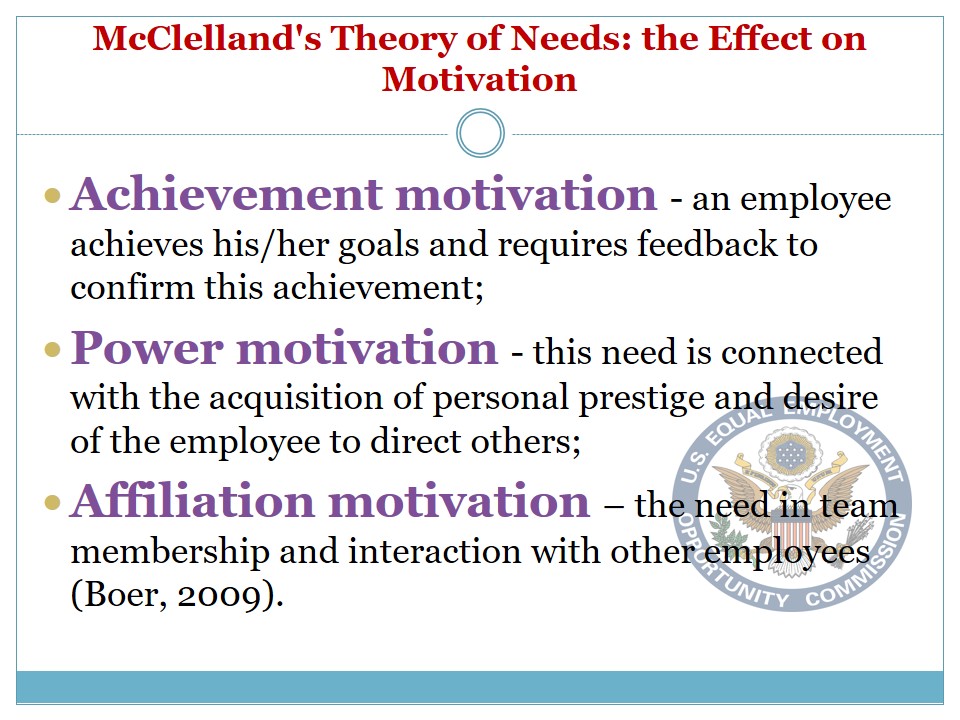
Summary (Conclusion)
- According to the ADA Act passed in 1990, all the employees, irrespective of their physical and cognitive impairment, should have an opportunity to apply for a desirable position and build career in a particular field.
- There are three major theories through which it is possible to trace the effect of discrimination in the workplace on the employees’ motivation.
- Individual needs of every employee with disabilities have to be satisfied for a person to have strong motivation and, therefore, high productivity and effectiveness.
In sum, the employers should be driven by these three theories when they employ the individuals with disabilities. The employers should not only ensure that there is no discrimination in the workplace with regards to such individuals, but that everything possible is done to meet their needs and, thus, to motivate them. Maslow’s, Alderfer’s, and McClelland’s theories may be quite useful at this because they account for different needs that employees may have to be satisfied with their jobs.
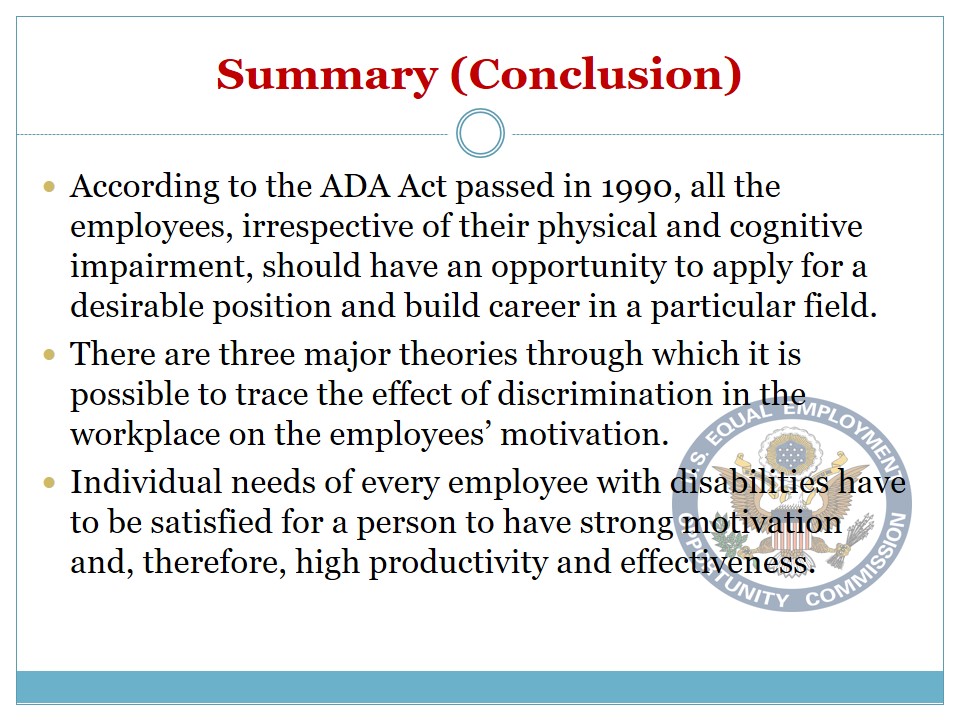
Reference List
Boer, J. (2009). Personal development. New York: Routledge.
Bogardus, A. (2009). PHR / SPHR Professional in Human Resources Certification Study Guide. New York: John Wiley and Sons.
Harris, O.J. & Hartman, S.J. (2001). Organizational behavior. New York: Routledge.
Jones, N.L. (2003). The Americans with Disabilities Act (ADA): overview, regulations and interpretations. New York: Nova Publishers.
Koontz, H. & Weihrich, H. (2006). Essentials of management. New York: Tata McGraw-Hill.
Mathis, R.L. & Jackson, J.H. (2007). Human resource management. Mason: Cengage Learning.
Miller, M.D. & Holness, L.A. (1998). You and the law in New Jersey: A resource guide. New Jersey: Rutgers University Press.
Podmoroff, D. (2005). 365 ways to motivate and reward your employees every day. Ocala: Atlantic Publishing Company.
Regmi, K., Naidoo, J. & Regmi, S. (2009). Understanding the effect of discrimination in the workplace: A case study amongst Nepalese immigrants in the UK. Equal Opportunities International 28(5), 398-414.
Saxena, P.K. (2009). Principles of management: A modern approach. New Delhi: Global India Publications.
Spechler, J.W. (1996). Reasonable accommodation: Profitable compliance with the Americans with Disabilities Act. London: CRC Press.
Youngberg, B.J. (1998). The Risk manager’s desk reference. Maryland: Aspen Publishers, Inc.
Yuen, F.K., Skibinski, G.J., & Pardeck, J.T. (2003). Family health social work practice: A knowledge and skills casebook. New York: Routledge.